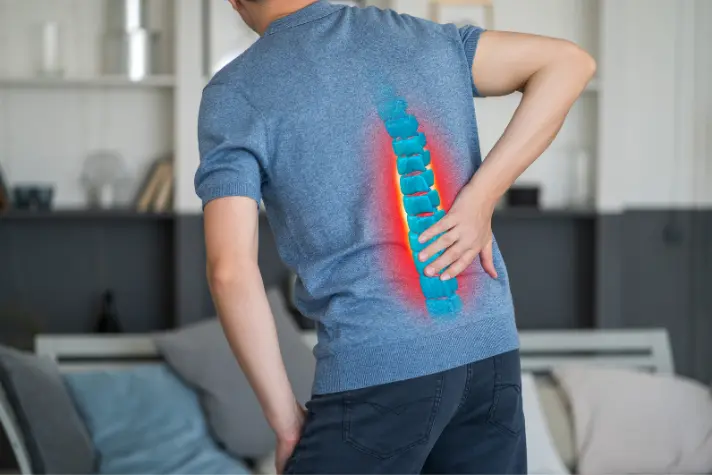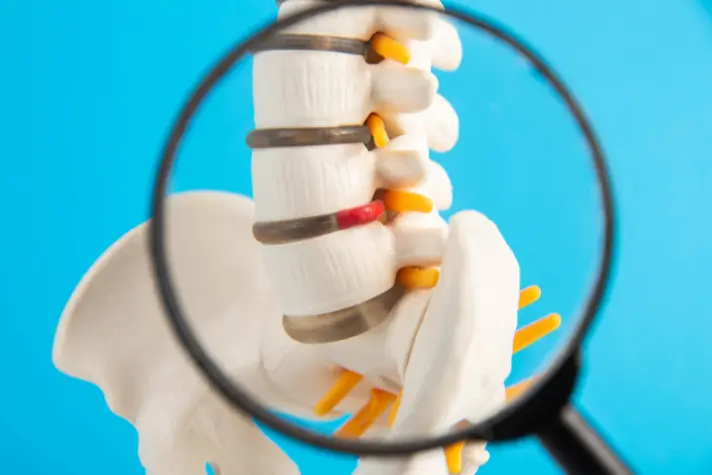
Spondylolisthesis is a common condition that impedes a person’s quality of life, causing pain and a lack of mobility. This could result in chronic stress stopping a person from enjoying their normal activities, and possibly impacting their social life.
In this article, we will discuss living with spondylolisthesis and the lifestyle changes that could be made to improve a person’s quality of life.
We will also focus on available treatments, both traditional and alternative, that can help someone manage their pain and alleviate any other symptoms caused by this spinal condition.
What is Spondylolisthesis?

Spondylolisthesis is a spinal condition that can cause pain in various areas of the body, depending on where on the spine it occurs. It involves one of the spinal bones known as the vertebrae ‘slipping’ forward and coming into contact with the vertebrae below it.
Usually, nonsurgical treatment can be effective in relieving any symptoms but this is not always the case, and for more severe cases, surgery may be the recommended course of action.
Spondylolisthesis Causes
The two main causes of spondylolisthesis are age-related wear and tear and overextending the spine, although some people may develop the condition congenitally.
Overextension

Often affecting young adults, overextending the spine can happen when playing sports, especially contact sports which can cause the body to move unnaturally. American football is a prime example of a sport that commonly causes back injuries.
However, other sports that require twisting and unnatural movements can also include gymnastics, diving, and volleyball.
Age
Over the decades, a person’s spine has worn down due to general activities, especially those who work in manual jobs. However, exercise and sports also apply additional pressure on the spine, especially ones that are high-impact and frequently cause shocks to the back. Spine degradation can also be accelerated by maintaining a poor posture.
The discs in the spine, the soft tissue that sits between the vertebrae are one of the most likely areas to suffer degradation. Over time these discs can lose moisture and lose their shape, stopping them from acting as shock absorbers between the spinal bones. The vertebrae themselves can also lose density as a person ages, making them prone to fractures.
This is why spondylolisthesis is more common among patients who are aged 60 and above.
Genetics
Some individuals may develop spondylolisthesis due to their genetics, especially those who are done with thinner-than-normal bone structures in their spine. This lack of spinal durability makes them more susceptible to back injuries which can eventually lead to conditions such as spondylolisthesis.
Grades of Spondylolisthesis
There are three grades of spondylolisthesis based on the severity of the condition.
- Grade 1 spondylolisthesis – the vertebra has slipped between 1% – 25%
- Grade 2 spondylolisthesis – the vertebra has slipped by up to 50%
- Grade 3 spondylolisthesis – the vertebra has slipped by up to 75%
- Grade 4 spondylolisthesis – the vertebra has slipped between 76% – 100%
- Grade 5 spondylolisthesis – the vertebra has slipped by more than 100%, this is referred to as Spondyloptosis.
For grade 1 spondylolisthesis, surgery is unlikely needed and the symptoms can be reduced with standard medical treatment. However, sometimes the pain can still be very severe if treatments fail to reduce symptoms. Therefore surgery may be the only option.
One type of spondylolisthesis stage 1 surgery is a mechanical spinal device that replaces the affected vertebrae. This allows the patient to retain full mobility in the spine, something that is not possible with a procedure such as spinal fusion that uses a bone graft.
Making Positive Changes To Your Lifestyle To Reduce Spondylolisthesis Symptoms

A person’s diet, activity level, and habits can have a significant impact on their spinal health. Unhealthy people are much more prone to developing a back condition compared to those who watch what they eat, stay in shape, and do not smoke cigarettes.
Below are some factors a person should consider to maintain a healthier lifestyle, especially if they are looking to reduce the symptoms of spondylolisthesis.
- Diet – Eating healthily should be a primary concern for anyone suffering from back issues. Processed foods in particular that contain additives, preservatives, and omega-6 can contribute to inflammation, as can other foods such as red meat and food that is high in sugar or fat. Instead, you should focus on eating plenty of fish, greens, nuts, seeds, and unprocessed grains.
- Exercise – Always make sure you get enough regular exercise to maintain the strength in your back muscles. This can be as simple as a daily walk or bike ride, swimming twice a week, or taking aerobics classes.
- Sleep – Getting a full night’s rest can help reduce stress levels, while also ensuring enough water and nutrients reach the discs in your spine. If you are struggling to sleep, then it may be a good idea to invest in a supportive, ergonomic mattress.
- Quit smoking – A good decision in general as smoking can lead to a range of serious health issues, but smoking can also speed up deterioration of the vertebrae and discs.
Spondylolisthesis Treatment Options
Most spondylolisthesis patients experience great results from traditional treatment options but this is not always the case. Each individual’s body is different and some people respond better to minor lifestyle changes or alternative treatments. Many people around the world also don’t want to rely on painkillers which can become addictive, instead preferring herbal supplements and regular massage therapy.
Physical therapy helps to strengthen back muscles that support your spine, helping to ease pain symptoms and potentially cure the symptoms altogether. However, some people find that simply practicing yoga or pilates in their spare time can have similar results.
It is always recommended to stay active if you have a spine condition such as spondylolisthesis as sitting and resting for long periods can result in more inflammation and increase pain. Activities such as walking, cycling, or swimming are considered to be the best activities for anyone suffering from back pain.
About The Author:
Stacey Smith is a freelance health writer. She is passionate about writing about women’s health, dental health, diabetes, endocrinology, and nutrition and provides in-depth features on the latest in health news for medical clinics and health magazines.




